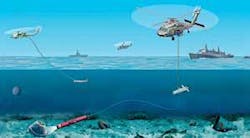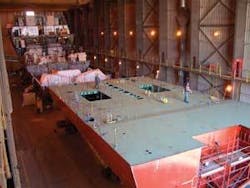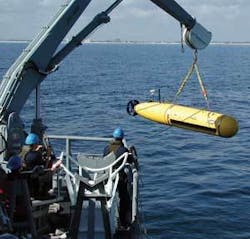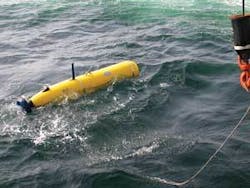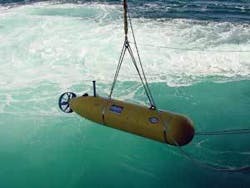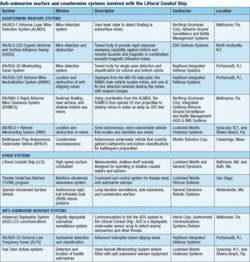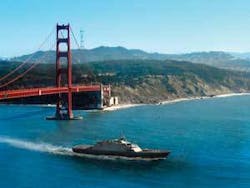New ship takes lead in countermine and anti-submarine warfare
The Navy’s Littoral Combat Ship will use a broad range of autonomous and semiautonomous surface and subsurface vehicles, as well as advanced networking communications, to bring the nation’s anti-submarine and countermine warfare capabilities to bear against terrorists as well as conventional foes in dangerous coastal waters.
By John Keller
The U.S. Navy’s Littoral Combat Ship (LCS), a shallow-draft, fast, and maneuverable warship specially designed for dangerous coastal and harbor operations, will be a showcase of some of the most modern integrated systems for anti-submarine warfare (ASW) and countermine operations when the first ship of the class takes to the seas in 2008.
The LCS will be able to deploy a wide variety of sensors for antisubmarine and countermine warfare from several flying, floating, and submersible manned and unmanned vehicles, as well as use conventional submarine- and minehunting systems to keep sensitive coastlines open for U.S. military operations.
The new ship has a helicopter deck and hangar capable of accommodating as many as two MH-60R/S helicopters, as well as a tactical unmanned air vehicle (UAV), and will be able to launch and recover its aircraft in conditions as severe as 27-knot wind gusts and waves nearly 10 feet high.
The MH-60S and MH-60R helicopters from the Lockheed Martin Corp. Systems Integration division in Owego, N.Y., are based on the Sikorsky Aircraft Corp. UH-60 helicopter airframe. The S model is fitted with systems optimized for countermine warfare, and the R model is optimized for locating, tracking, and attacking enemy submarines.
In addition, the LCS will be able to launch and recover manned and unmanned surface vessels and unmanned underwater vehicles (UUVs) in 21-knot winds and waves as high as five feet.
Two ships are under contract to two separate contractor teams-the Lockheed Martin Corp. LCS team in Baltimore, which is designing a high-speed semiplaning monohull vessel, and the General Dynamics Bath Ironworks LCS team in Bath, Maine, which is designing a high-speed trimaran with a slender stabilized monohull.
Although the designs of the two companies will look strikingly different, they both are to meet the same set of Navy requirements, which involve autonomous systems as one of the chief enablers of the LCS.
This new breed of warship may have one of the smallest crews of any surface combatant. The LCS will have a crew of between 15 and 50, with accommodation for as many as 75 ship and special-mission crew.
To put it in perspective, the LCS is roughly the size of a Navy frigate, which has a crew of about 200. Yet the LCS has a crew complement as small as that of a Coast Guard patrol vessel. To make up for its relatively small crew size, the LCS will use a high degree of system autonomy as it seeks to keep the oceans clear of hostile submarines and anti-shipping mines.
Perhaps the most important mission of the LCS is detecting and destroying enemy mines designed to damage or destroy military and commercial shipping with floating, moored, or bottom-placed munitions.
Airborne Laser Mine Detection System
The first countermine system aboard the LCS is called the AN/AES-1 Airborne Laser Mine Detection System (ALMDS), which is under contract to the Northrop Grumman Corp. Airborne Ground Surveillance and Battle Management Systems segment in Melbourne, Fla.
Northrop Grumman is designing and building the ALMDS under terms of a $124.5 million Navy contract awarded in September 2005.
Called the first new technology to be applied to mine hunting since the advent of sonar, the ALMDS uses a laser-based technology mounted to an MH-60S helicopter called light detection and ranging, or LIDAR, to detect, classify, and localize floating and near-surface moored sea mines using a blue-green laser.
By using lasers to detect mines, rather than towed sonar systems, Navy leaders expect to speed the process of finding and destroying mines. The laser-based system does not require the launch and recovery of specialized minehunting systems.
Areté Associates in Arlington, Va., is providing Northrop Grumman with the LIDAR sensor for the ALMDS system. Meanwhile, Meggitt Western Design in Irvine, Calif., is building an environmental control system chiller to provide a constant supply of regulated-temperature fluid to the system.
Organic Airborne and Surface Influence Sweep
Another component of the LCS’s counter-mine warfare capability is the AN/ALQ-220 Organic Airborne and Surface Influence Sweep (OASIS) system from EDO Defense Systems in North Amityville, N.Y. The system is towed from an MH-60S helicopter that deploys from the LCS.
Once other systems find hostile mines, the OASIS system is designed to trigger the mines at a safe distance by emitting an electromagnetic and acoustic signature. “It fuses the mine by making the mine think there is a ship nearby,” explains Vince Gac, undersea warfare product director at EDO. “It is designed to approach the minefield from the edges, then cut in, and detonate the mines outside the risk envelope of the towed system itself.”
OASIS is particularly useful in muddy or cluttered water where other kinds of sensors and minesweeping systems might not work effectively. This capability is of critical importance coastal waters, straits, choke points, and whenever there is little time for minehunting operations.
OASIS has six major components: the towed body, the magnetic influence subsystem, the acoustic influence subsystem, the control/monitoring and power subsystem, the common console OASIS software, and the tow cable interface.
The towed body is hydrodynamically stable in all control modes while being towed in a straight course and while making turns. The towed body measures its tow depth and its height above the bottom, and uses this data to find the best depth for minesweeping. The tow cable distributes power, and communicates with the aircraft.
“Internally we have the towed body that flies itself in a bottom-following mode where we use a transducer to hug the bottom,” Gac says. “We take power from the helo, and send it down to different transformers in the system. Electricity flows from the two electrodes, and makes a magnetic field in the water.
“We generate an acoustic signature with a cavitating impeller on each side of the craft,” Gac continues. In the future possibly may look at a superconducting type system, or toward a solenoid-type sweep with superconducting elements to generate a larger field.”
Minehunting Sonar System
Another weapon in the LCS arsenal against enemy mines is the AN/AQS-20 Minehunting Sonar System, a towed body for single-pass detection and classification of volume and bottom mines from Raytheon Integrated Defense Systems in Portsmouth, R.I.
The AQS-20 uses imaging sonars, signal processing, and computer algorithms to localize mine-like objects and alert the system operator with a visual image and a contact data list, Raytheon officials say.
The system, which can be towed by MH-53E and MH-60S helicopters, surface vessels, and the unmanned AN/WLD-1 Remote Minehunting System, is 10.5 feet long, 15.5 inches in diameter, and weighs 975 pounds. It has common hardware, software, and interfaces, as well as common integrated logistic support and operational configurations, Raytheon officials say.
At the heart of the AQS-20’s minehunting capabilities are a combination of sidescan, forward-looking, and gap-filler sonar sensors, and an electro-optic identification (EOID) capability that yields high-definition images of bottom mines using streak-tube imaging LIDAR, otherwise known as STIL technology, from Raytheon partner Areté Associates Optical Engineering in Tucson, Ariz., says Lou Varrichione, director of maritime sensor systems at Raytheon Integrated Defense Systems.
The system sends sonar and imaging data up its fiber-optic tow cable to the operator console located either aboard the host helicopter or by wireless data links to operators aboard nearby surface vessels. The operator’s station has a high-speed data recorder to store mission information for later analysis.
Airborne Mine Neutralization System
Once the LCS systems detect mines, Navy commanders need a way to destroy the mines or render them harmless. That is where the AN/ASQ-235 Airborne Mine Neutralization System (AMNS) from Raytheon Integrated Defense Systems in Portsmouth, R.I., comes in.
Deployed and towed from the MH-60S helicopter, the ASQ-235 takes data from other countermine sensors, pinpoints the locations of the mines, and then destroys them with one of the four expendable munitions attached to the ASQ-235 vehicle.
In efforts to control costs and facilitate maintenance and upgrades, Raytheon designers use the same vehicle form factor for the ASQ-235 Airborne Mine Neutralization System as they did with the AQS-20 Minehunting Sonar System. The ASQ-235 “has four tethered neutralizers on optical fiber,” explains James Normington, senior program manager for undersea sensor systems at Raytheon Integrated Defense Systems.
“The vehicle does a pass, detects and classifies any mines, and deploys a neutralizer vehicle, what has a shaped charge in its nose,” Normington continues. “It swims up and puts its nose against the mine and detonates itself to destroy or neutralize the mine.”
The anti-mine system consists of a control console and a launching mechanism for its four unmanned underwater vehicles, which are tethered to the primary ASQ-235 vehicle with fiber-optic cable and equipped with video and sonar sensors to detect and pinpoint anti-shipping mines.
Rapid Airborne Mine Clearance System
The ASQ-235 system, however, is not the only way the LCS can destroy anti-shipping mines. Another system on the LCS’s MH-60S helicopter is the AN/AWS-2 Rapid Airborne Mine Clearance System (RAMICS) from the Northrop Grumman Corp. Integrated Systems Airborne Ground Surveillance and Battle Management Systems segment in Melbourne, Fla.
The AWS-2 system takes coordinates from the Northrop Grumman AN/AES-1 Airborne Laser Mine Detection System and fires special 20 mm projectiles to destroy mines quickly in water as deep as 300 feet.
The mine coordinates pass to the AWS-2 controller, which automatically directs and holds a stabilized rapid-fire gun on the target. The stabilized gun usually fires a burst of between 20 and 50 projectiles, which have a shape and speed to produce a cavitation envelope in which the projectile rides at very low drag.
The ASQ-235 projectile strikes the mine at a velocity sufficient to penetrate the mine and release a reactive material into the explosive to detonate and destroy it.
Battlespace Prep Autonomous Underwater Vehicle
The helicopter is not the only platform from which the LCS can deploy weapons to find and destroy hostile mines. One of the most important countermine systems aboard the ship is the Battlespace Prep Autonomous Underwater Vehicle (BPAUV) countermine reconnaissance system from Bluefin Robotics Corp. in Cambridge, Mass.
This autonomous underwater vehicle, which the LCS lowers into the water by crane, covertly gathers bathymetry to map the ocean bottom near shore to detect physical changes that might indicate the presence of hostile anti-shipping mines. The BPUAV can operate not only from the LCS, but also from small vessels the size of launches or fishing boats.
“The primary mission is to do surveys and collect side-scan sonar data of what is on the bottom,” explains Christopher Wallsmith, chief knowledge officer at Bluefin Robotics. The fully autonomous robot submarine can operate completely on its own or with the help of an operator when the vehicle is on the surface, using the Iridium satellite communications system.
“It comes to the surface to get a Global Positioning System fix to improve its navigational efficiency, and to report to the operator,” Wallsmith says. It has a variety of dead-reckoning systems, an inertial measurement unit, and a Doppler velocity sonar sensor log to measure its speed over the bottom. It also collects environmental information.
The BPAUV has a side-scan sonar system that projects sound out to the sides of the vehicle, Wallsmith explains. “It detects anything up to 150 meters along either side of the vehicle. When the operator comes back and looks at that data, it looks like visual imagery and he can scroll through it on his screen. There are patterns of bright spots and shadows that the operators are trained to look for.”
The current version of the LCS does not process the BPAUV data while it is underway, Wallsmith says. “It will just gather all the data there and bring it back to the mother ship and the operator goes through the data and manually picks objects out, or he can use automated detection software.”
The BPAUV is designed for deployments as long as 15 hours on power from lithium polymer batteries, which are environmentally enclosed and rechargeable.
Although the BPAUV is designed to survey the ocean environs, the vehicle could be adapted for anti-submarine warfare-related missions, Wallsmith says. For example, the vehicle could tow an acoustic sonar array behind it, or settle on the bottom of the ocean in low-power mode and wait for a sound to trigger its sensor systems. All ASW applications for the BPAUV are in prototype development, he says.
The BPAUV weighs 800 pounds, is 122 inches long, 21 inches wide, uses lithium polymer batteries and has an operational speed of three knots.
Remote Minehunting System
One of the most innovative minehunting systems in the LCS arsenal is the AN/WLD-1 Remote Minehunting System (RMS)-a 23-foot-long semiautonomous, semisubmersible vehicle that locates and classifies sea mines. The system’s manufacturer is the Lockheed Martin Undersea Systems division in Riviera Beach, Fla.
The AN/WLD-1, which can function under control of a human operator or completely on its own, essentially is a small diesel-powered submarine with a snorkel and antenna mast that always sticks out of the water. “It is a small snorkeling diesel submarine,” says John Brandes, the system’s chief engineer at Lockheed Martin. “With the mast up it has over-the-horizon and line-of-sight radio communications, and continuous Global Positioning System positioning. It doesn’t break the connection to the surface.”
The system’s mission is to detect and localize targets in the water so other systems can come back and destroy them later or so Navy commanders can switch alter their missions to avoid minefields.
The AN/WLD-1 system can operate for the better part of a day, and is scheduled for deployment in summer 2007 aboard Arleigh Burke-class guided missile destroyers hull numbers 91 through 96, says Tish Rourke, the system’s program manager at Lockheed Martin.
The system has an onboard camera, which helps the vehicle navigate and avoid obstacles, according to Navy requirements. Eventually Lockheed Martin engineers plan to improve the system’s ability to avoid obstacles on its own with additional sensors and sensor processing.
Its primary sensor is the Raytheon AN/AQS-20 Minehunting Sonar System (see above), which the AN/WLD-1 tows behind it at variable depths to locate mines.
“We have worked with Raytheon to do some slight modifications to integrate the AQS-20 within the system,” Brandes says. “We are using that sensor package, the variable-depth sonar, or an electro-optical identification device (EOID) to perform minehunting operations.”
Stability in rough seas is a prime requirement of the AN/WLD-1 to keep the towed AQS-20 operating at peak effectiveness, Brandes says. “To operate near the surface of the ocean and maintain a stable platform through various sea states is a challenge,” he explains. “The control system, feedback, and specially designed fins give the vehicle a great deal of control, so that it is as stable as a 200-foot ship.”
Although the AN/WLD-1 and its towed AQS-20 is designed for sea surveillance and countermine operations, Navy and Lockheed Martin experts envision future versions designed for anti-submarine warfare. The Sea Talon research program is a step toward that goal.
“The concept is you take out the AQS-20 and put on sensors more conducive to finding submarines,” Brandes says. More importantly, the Sea Talon program seeks to demonstrate autonomous vehicles working as a team able to detect and locate hostile submarines, which Brandes calls “a multistatic, or bistatic approach to anti-submarine warfare.”
This concept seeks to place sonar emitters and receivers on separate vehicles. “Look at how surface ships hunt for submarines with a ping and return,” Brandes explains. “Now we’ve found that if you can put a broadband large ping into the water, that energy will bounce off the submarine. You can have passive arrays that pick up that energy. If they know the size, time, and location of the original ping, they can work to figure out what the contacts are and can work as a team to geolocate the contact.”
More research into multivehicle autonomy will be necessary to bring this concept to fruition, Brandes says. “Building a multivehicle, autonomous-vehicle-control technology path going forward is a key enabler for this system, so that vehicles can autonomously work together or one operator can control more than one vehicle.”
Spartan Unmanned Surface Vehicle
In addition to submersible unmanned vehicles, the LCS will be able to deploy an unmanned surface vehicle (USV) called Spartan, an autonomous rigid-hull inflatable-boat (RHIB) sensor platform for long-duration surveillance, anti-submarine, and countermine warfare. Building the Spartan platform are engineers at General Dynamics Robotic Systems in Westminster, Md.
Spartan will utilize towed sonar arrays, dipping sonar sensors, and acoustic sources as payloads to carry out its antisubmarine warfare mission.
“The USV command-and-control computing hardware and sensors leverage our autonomous mobility and tactical behavior technologies and the field-proven systems,” says Scott Myers, president of General Dynamics Robotic Systems. “Sensor-driven automated maritime situation awareness is the critical technology that will enable autonomous SUVs for Navy missions.
Teaming with General Dynamics on the Spartan unmanned RHIB project are Navatek Ltd. in Honolulu; Micro-Analysis and Design Inc. in Boulder, Colo.; Signal Systems Corp. in Severna Park, Md.; International Logistics Systems Inc. in Glen Rock, Pa.; and Chesapeake Sciences Corp. in Millersville, Md.
Advanced Deployable System
The LCS will be able to lay down an anti-submarine underwater sonar array called the Advanced Deployable System (ADS), which uses distributed passive acoustic bottom-mounted arrays wirelessly linked to an analysis and reporting system to provide continuous acoustic coverage over large areas of the ocean.
The ADS is designed specifically to detect and track modern diesel electric and nuclear submarines, as well as track surface ships and detect sea mine laying. Building the ADS is the Lockheed Martin Corp. Maritime Systems and Sensors division in Manassas, Va.
The ADS consists of four major subsystems: analysis and reporting system, sensor, tactical interface, and installation support. This variant of the ADS will deploy from the LCS deck. The system will have a series of passive, bottom-fixed, battery-powered hydrophones connected to an anchored buoy and linked to a processing station aboard the LCS.
Linking ADS data to the LCS is a ship- and buoy-borne radio and data-processing system from the Harris Corp. Government Communications Division in Melbourne, Fla. Harris Partner Spectrum Signal Processing Inc. in Burnaby, British Columbia, is providing signal processing products and services for use in both ship borne and buoy components of the ADS.
The ship-borne radio platform will use Spectrum’s HCDR-1000 High Channel Density Receiver VME-based platform, which will link to several communications buoys and pass data back to a central data-processing station.
Airborne Low Frequency Sonar
Rounding out the LCS array of anti-submarine warfare equipment is the AN/AQS-22 Airborne Low Frequency Sonar (ALFS) helicopter-based dipping sonar system from Raytheon Integrated Defense Systems in Portsmouth, R.I. The AQS-22 dipping sonar will deploy from the MH-60R helicopter aboard the LCS.
The AQS-22 is designed to detect and classify hostile submarines at greater ranges than currently deployed dipping sonar systems, and can reach depths near 2,500 feet while deployed from the helicopter on a hardened coaxial cable tether.
Raytheon teams on the AQS-22 with Thales Underwater Systems in Brest and Sophia, France. Thales manufactures the system’s hydrophone stave arms, as well as the active transducer system.
The sonar system has seven weapon-replaceable assemblies: the acoustic processor equipment, sonar transmitter/receiver, reeling machine interface unit, reeling machine control unit, reeling machine, reel and cable, and the transducer assembly.
The hydrophone staves use beam forming and signal processing to detect the presence of submarines and to determine the submarine’s location, range, and bearing.
Key components of the AQS-22’s signal-processing system are field programmable gate arrays, as well as single-board processors from Curtiss-Wright Embedded Computing in Ottawa, says Lawrence Epstein, director of engineering at Raytheon Integrated Defense Systems.
